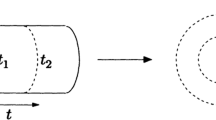Abstract
I give an interpretation of the fundamental theorem of algebra based on supersymmetry and the Witten index. The argument gives a physical explanation of why a real polynomial of degreen need not haven real zeroes, while a complex polynomial of degreen must haven complex zeroes. This paper also addresses in a general and model-independent way the statistics of the perturbative ground states (the states which correspond to classical vacua) in supersymmetric theories with complex and with real superfields.
Similar content being viewed by others
References
Ahlfors, Lars V.: Complex Analysis: An Introduction to the Theory of Analytic Functions of One Complex Variable. New York: McGraw-Hill, 1966
Alvarez-Gaumé, L.: Supersymmetry and the Atiyah-Singer Index Theorem. Commun. Math. Phys.90, 161–173 (1983)
Spector, D.: Supersymmetry and the Möbius Inversion Function. Commun. Math. Phys.127, 239–252 (1990)
Witten, E.: Dynamical Breaking of Supersymmetry. Nucl. Phys.B188, 513–554 (1981)
Witten, E.: Constraints on Supersymmetry Breaking. Nucl. Phys.B202, 253–316 (1982)
Witten, E.: Topological Quantum Field Theory. Commun. Math. Phys.117, 353–386 (1988)
Author information
Authors and Affiliations
Additional information
Communicated by R.H. Dijkgraaf
Rights and permissions
About this article
Cite this article
Spector, D. Supersymmetry, vacuum statistics, and the fundamental theorem of algebra. Commun.Math. Phys. 177, 13–25 (1996). https://doi.org/10.1007/BF02102428
Received:
Accepted:
Issue Date:
DOI: https://doi.org/10.1007/BF02102428




